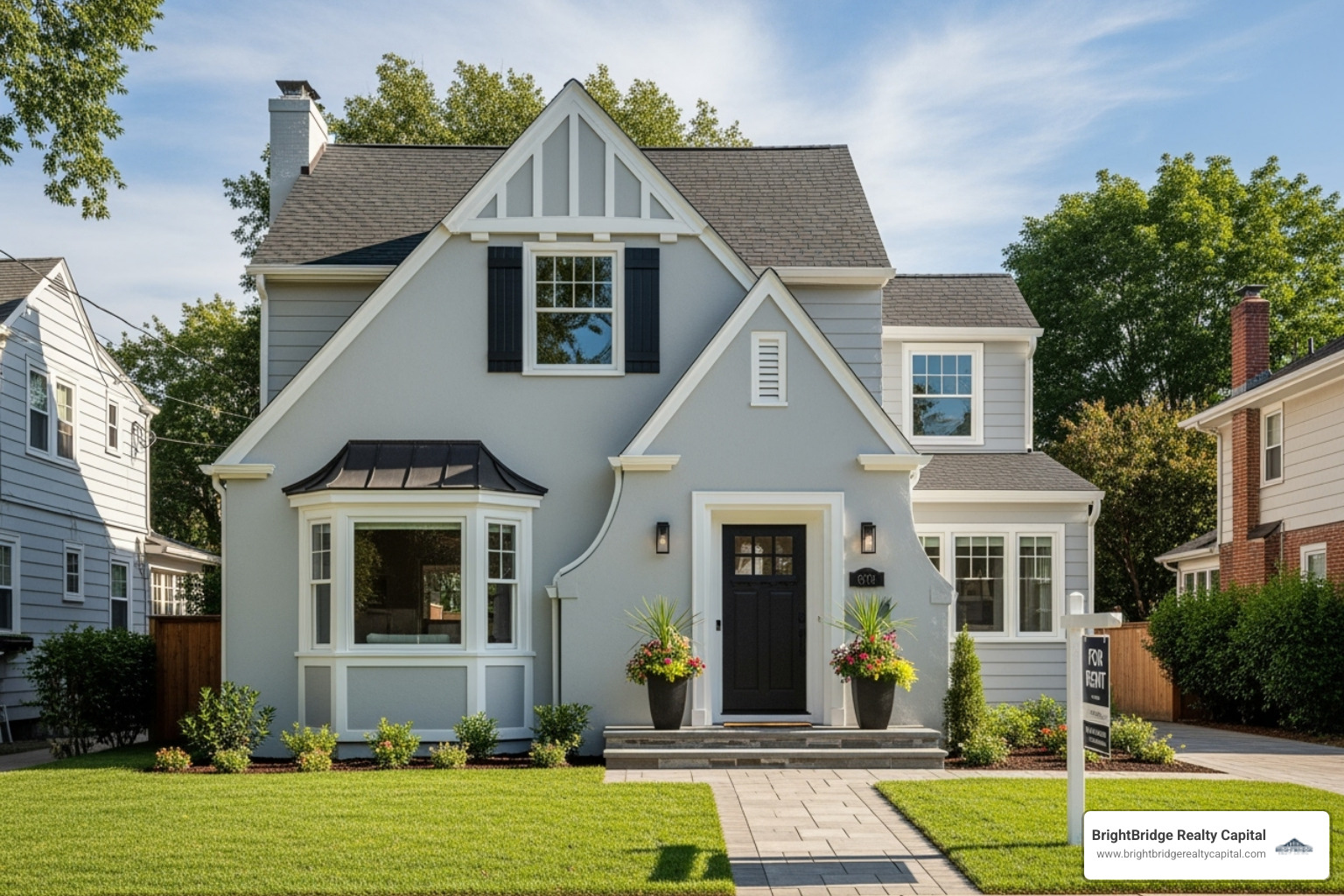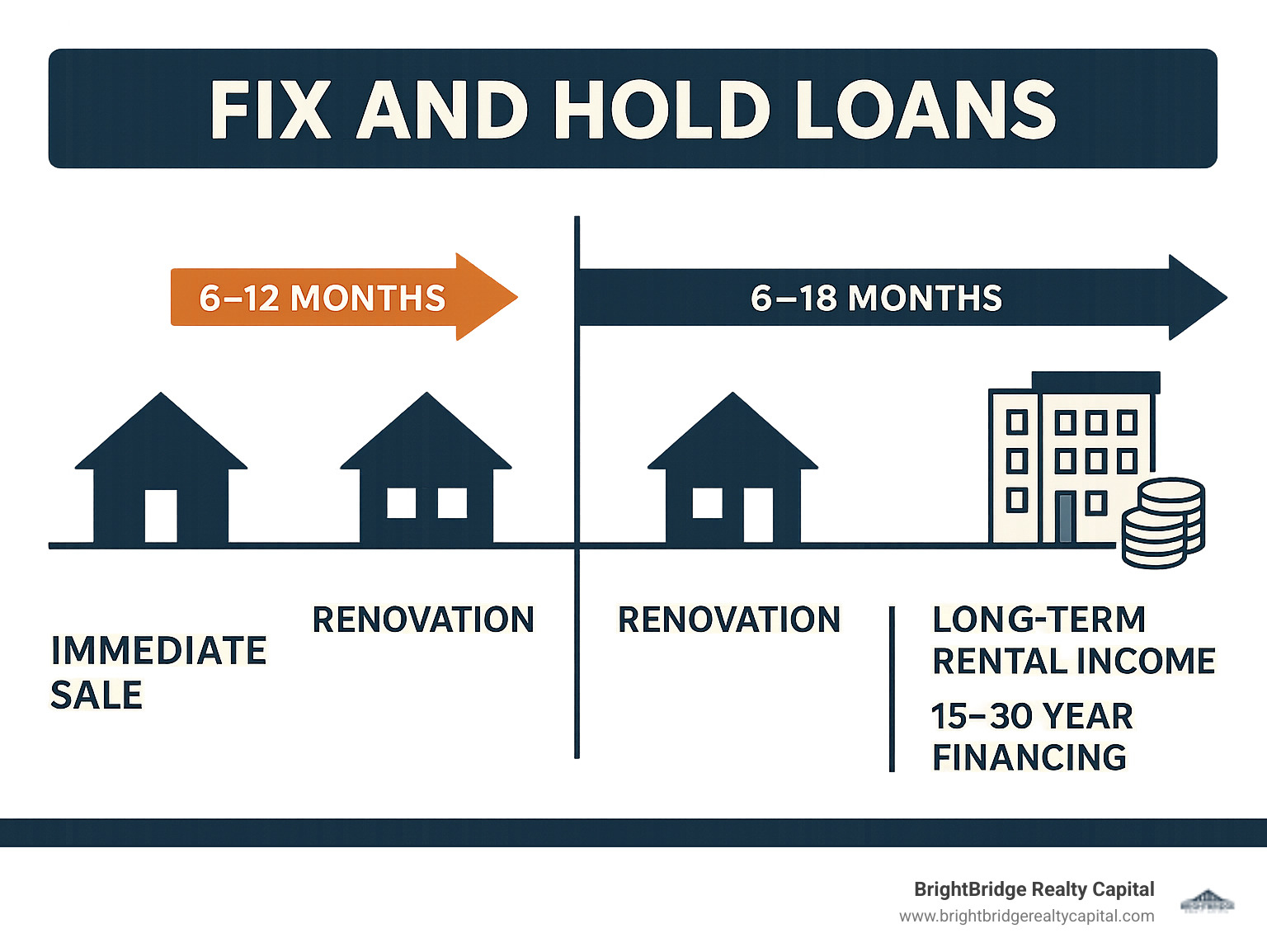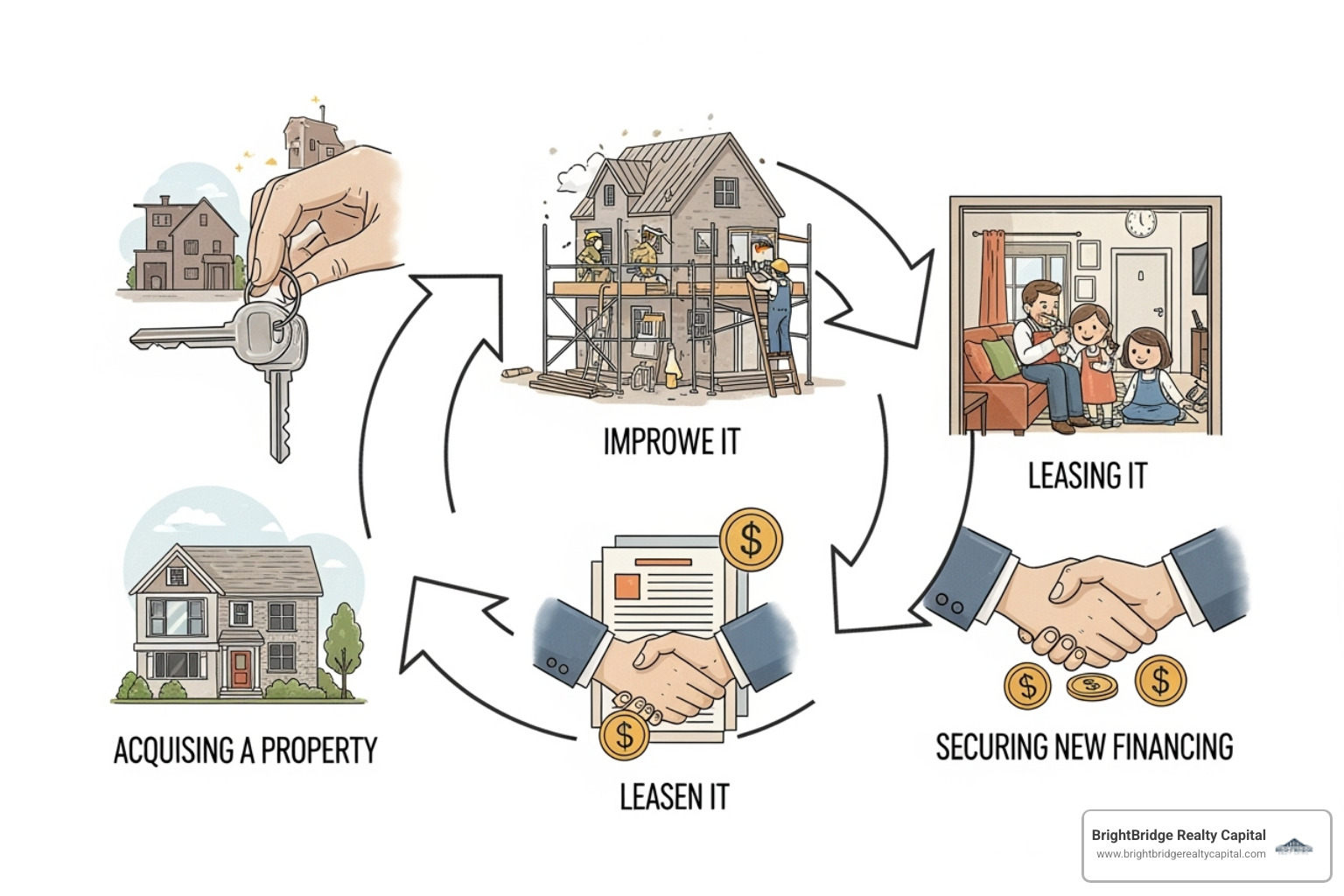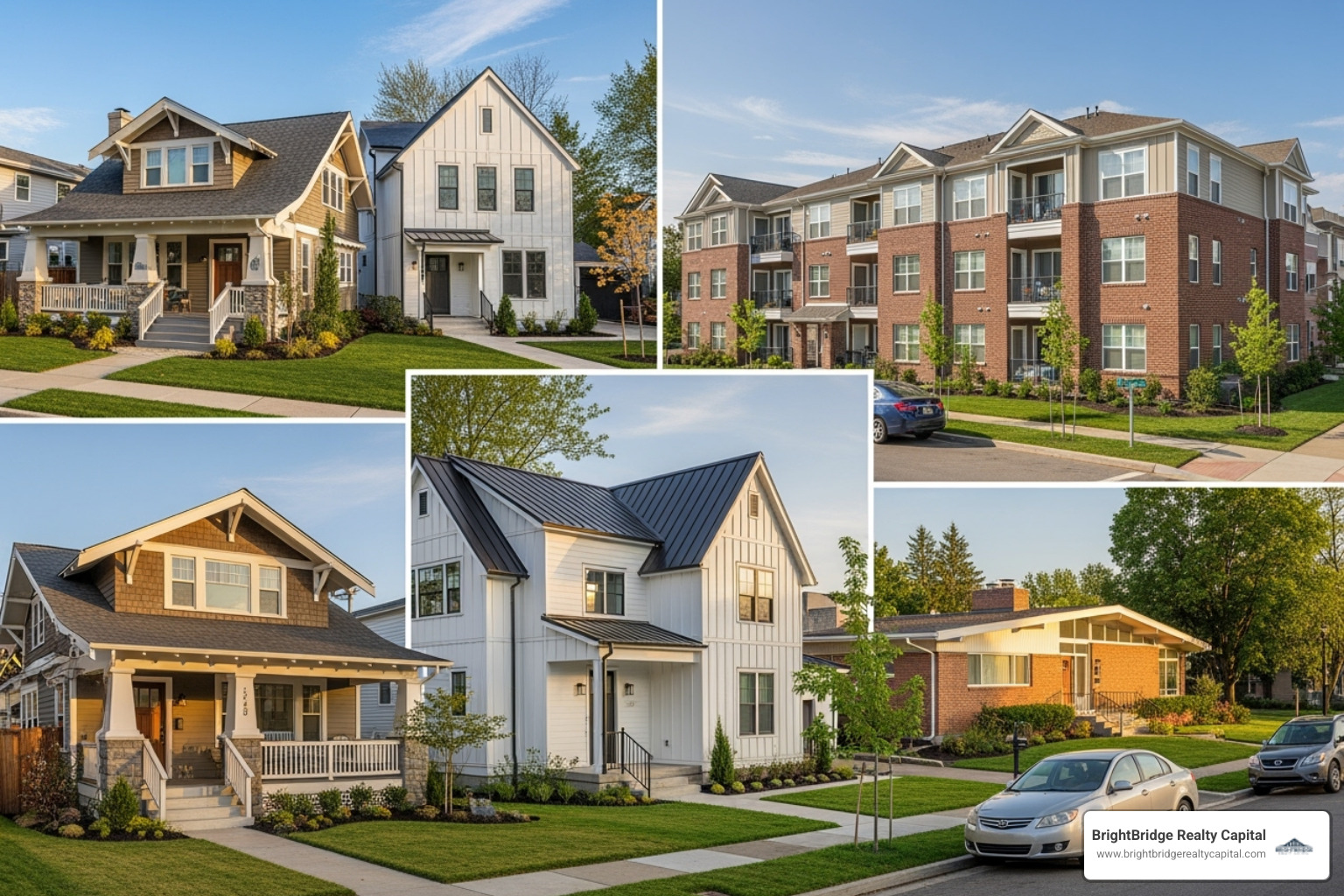From Flip to Fortune: A Guide to Fix and Hold Loans

Building Wealth Beyond the Flip
Fix and hold loans are specialized financing solutions carefully crafted for real estate investors who see beyond the immediate profit of a quick sale. These loans empower investors to purchase properties in need of repair, finance the necessary renovations, and then retain them as long-term rental assets. This strategy is the cornerstone of building sustainable wealth through consistent passive income and long-term market appreciation.
While flipping properties can generate substantial, fast profits, the most astute investors recognize the profound wealth-building power of the "hold" strategy. Instead of selling a renovated property for a one-time gain, they convert it into a durable income-producing asset. This approach transforms a single transaction into a recurring, long-term income stream. The renovated property not only generates monthly cash flow from rent but also appreciates in value over time, allowing equity to build naturally. It represents the fundamental shift from earning a one-time paycheck to building a self-sustaining financial engine.
Key Features of Fix and Hold Loans Explained:
- Purpose: These loans are uniquely designed to finance both the acquisition and the complete renovation of an investment property intended for long-term rental. This all-in-one structure simplifies the financing process, eliminating the need to secure separate loans for purchase and construction.
- Structure: The loan typically begins as a short-term instrument, lasting anywhere from 6 to 18 months, to cover the renovation period. During this phase, payments are often interest-only to preserve cash flow. Upon completion of the rehab and stabilization of the property (i.e., renting it out), the loan is converted or refinanced into permanent, long-term financing.
- Down Payment: A significant advantage is the lower capital requirement. Fix and hold loans often require a down payment of only 10-20%, a stark contrast to the 20-25% typically demanded for traditional investment property mortgages. This allows investors to conserve capital for other opportunities.
- Loan Terms: The financing journey is a two-part process. It starts with the initial renovation phase loan, which is then strategically refinanced into a long-term rental loan with terms of 15, 20, or 30 years, providing stability and predictable payments for the life of the investment.
- Property Focus: These loans are ideal for distressed, outdated, or undervalued properties that conventional lenders would avoid. The focus is on the property's potential—its After-Repair Value (ARV)—rather than its current, imperfect condition.
- Exit Strategy: The primary exit from the initial short-term loan is not a sale, but a refinance. The ultimate goal is to hold the asset for years, collecting rental income and benefiting from market appreciation, rather than seeking a quick resale.
The primary challenge for this strategy is financing. Traditional mortgages are simply not built for properties that require significant repairs. Banks and conventional lenders have strict underwriting guidelines that often disqualify properties in poor condition. Furthermore, their loan approval process is notoriously slow, making it nearly impossible to compete in fast-moving real estate markets where cash offers and quick closings are king.
This is precisely where fix and hold loans bridge the critical gap. They offer the speed and flexibility essential for acquiring and renovating properties efficiently. They are designed to facilitate a seamless transition from a short-term construction project into a long-term, cash-flowing rental property.
I'm Daniel Lopez from BrightBridge Realty Capital. My career has been dedicated to helping investors steer this landscape. I've structured countless fix and hold loans that are custom to accommodate aggressive renovation timelines and the realities of competitive markets. My experience consistently demonstrates that securing the right financing is the pivotal element that can transform a single property purchase into the foundational asset of a thriving, wealth-generating rental portfolio.

Find more about Fix and hold loans:
What is a Fix and Hold Loan?
Imagine finding an undervalued property in a great neighborhood—a diamond in the rough. It needs significant work: a new roof, an updated kitchen, and modernized bathrooms. You see its immense potential to generate steady, reliable rental income for years to come. However, when you approach a traditional bank, they refuse to finance it because of its current condition. This is the exact scenario where fix and hold loans become an investor's most valuable tool.
These are not standard mortgages; they are highly specialized financing solutions engineered for investors with a vision. They are designed for those who want to purchase distressed or outdated properties, execute value-add renovations, and then hold them as long-term rental investments. Unlike strategies focused on quick profits, the fix and hold approach is about sustainable wealth creation. You aren't just fixing a house to sell it quickly; you are carefully crafting a valuable, income-producing asset that will generate monthly cash flow and appreciate in value for years, even decades.
One of the most powerful features of these loans is their ability to fund both the purchase price and the full renovation budget in a single transaction. This integrated financing allows you to confidently take on ambitious value-add projects that other investors, reliant on conventional funding, cannot. Whether it's converting an unused attic into a master suite, finishing a basement to add a legal rental unit, or completely overhauling the electrical and plumbing systems, fix and hold loans provide the necessary capital to transform a neglected property into a top-tier, income-generating asset.
How Fix and Hold Differs from Fix and Flip
While both strategies begin with buying and renovating a property, their philosophies, timelines, and financial underpinnings are fundamentally different.
Fix and flip investors are sprinters in the real estate race. Their goal is to acquire a property, renovate it as quickly and cost-effectively as possible, and sell it for a maximum profit, typically within a 6 to 18-month window. Their financing reflects this urgency, utilizing short-term, high-leverage loans that prioritize speed and a quick exit over long-term stability or favorable terms.
In contrast, fix and hold investors are marathon runners. They are methodically building a portfolio designed to generate equity and passive cash flow that can last for decades. Their focus is not on a single, large profit but on creating multiple, recurring income streams through a collection of rental properties. This strategy generates money month after month, year after year, creating a foundation for financial independence.
| Feature | Fix and Hold Loans | Fix and Flip Loans |
|---|---|---|
| Primary Goal | Long-term rental income and wealth appreciation | Quick, maximized profit from immediate resale |
| Loan Structure | Two-phase: Short-term renovation loan (6-18 months) followed by a long-term rental loan (15-30 years) | Single-phase, short-term loan (6-18 months) |
| Exit Strategy | Refinance into permanent financing and hold for rental income | Sell the renovated property on the open market |
| Investor Mindset | Portfolio builder focused on passive income, equity growth, and long-term wealth | Active operator seeking rapid returns and transactional profits |
| Risk Profile | Market risk, tenant management risk, long-term interest rate risk | Market risk, construction risk, short-term selling risk |
| Tax Implications | Potential for long-term capital gains, depreciation deductions, and other landlord tax benefits | Profits typically taxed as short-term capital gains or ordinary income |
The financing for each strategy is custom to these distinct goals. A fix and flip loan is designed to terminate upon the sale of the property. A fix and hold loan, however, is engineered to seamlessly transition into stable, long-term financing that supports your ongoing rental business. If you're curious about the flip side, you can find more info about fix-and-flip loans on our website.
The Two-Phase Loan Structure
This is where the genius of fix and hold loans truly becomes apparent. They are intelligently structured in two distinct phases that align perfectly with the investor's journey.
Phase One: Acquisition and RenovationThis initial phase is all about speed and execution. You receive a short-term loan that covers both the property's purchase price and the budgeted rehabilitation costs. During this 6 to 18-month period, you typically make interest-only payments. This is a crucial feature, as it keeps your monthly holding costs low while the property is a construction zone, generating no rental income. This structure preserves your capital for the renovation itself. This phase acts as a financial bridge, safely getting you from a distressed, non-income-producing property to a beautifully renovated, rent-ready asset. It provides the time and funding to handle everything from minor cosmetic updates to major structural overhauls.
Phase Two: Long-Term Hold and Income GenerationThis is where the strategy pays off. Once the renovation is complete and the property is stabilized—meaning it is leased to a qualified tenant—you refinance the short-term loan into permanent, long-term financing. This is frequently a DSCR (Debt Service Coverage Ratio) loan, a product designed for real estate investors. A DSCR loan qualifies the borrower based on the property's income potential rather than personal income, making it ideal for portfolio growth.
This refinance accomplishes several critical objectives. First, it replaces the higher-interest, short-term debt with a lower-interest, long-term mortgage with a fixed rate and a term of 15 to 30 years, resulting in predictable monthly payments. Second, it often allows for a "cash-out" refinance, where you can pull out a significant portion of the equity you created through the renovation. This tax-deferred cash can then be used as the down payment for your next investment property. This two-phase structure eliminates the stress and uncertainty of finding a new lender for the permanent financing, creating a seamless, integrated path from acquisition to long-term wealth building. To learn more about how this permanent financing works, check out more info about DSCR loans and how they support your rental property strategy.
The BRRRR Method and Fix and Hold Loans
If you spend any time in real estate investment circles, you will inevitably hear talk of the BRRRR method. This powerful, wealth-building strategy, which stands for Buy, Rehab, Rent, Refinance, Repeat, has become a blueprint for investors looking to scale their portfolios efficiently. Fix and hold loans are not just compatible with this method; they are the ideal financial vehicle to execute it flawlessly.
Think of the BRRRR method as a strategic, cyclical system for building a real estate empire. It's a repeatable process that allows you to acquire properties and grow your portfolio without constantly depleting your personal capital. The true elegance of the strategy lies in how the equity created in one cycle becomes the seed capital for the next, creating a powerful snowball effect. A modest initial investment can be methodically compounded into a substantial portfolio of cash-flowing rental properties.

This is where fix and hold loans become your strategic advantage. They are specifically engineered to support the BRRRR framework, providing the necessary capital, flexibility, and speed at each critical stage of the process.
Step 1 & 2: Buying and Rehabbing with a Short-Term Loan
The Buy and Rehab phases of the BRRRR method are where speed and certainty are paramount. Imagine you've identified the perfect distressed property in a hot market. The seller has multiple offers and wants to close quickly. While your competitors are bogged down in the slow, bureaucratic process of a conventional loan application, you can make a confident, near-cash offer.
This is where the short-term component of a fix and hold loan provides a decisive edge. At BrightBridge Realty Capital, we operate on the principle that in real estate investing, timing isn't just important—it's often the only thing that matters. Our fast funding advantage means we can often close a loan in as little as one week, empowering you to negotiate aggressively and secure deals that others cannot.
The loan is structured to cover both your acquisition financing and your renovation costs in one streamlined package. This eliminates the complexity of juggling multiple lenders or the risk of running out of rehab funds mid-project. We provide high Loan-to-Cost (LTC) ratios, often financing up to 90% of the purchase price and 100% of the renovation budget. For example, if you buy a property for $200,000 with a $50,000 rehab budget (total cost of $250,000), a 90% LTC loan would provide $225,000, leaving you with a minimal out-of-pocket investment.
Our lending is based on the After-Repair Value (ARV)—the projected market value of your property once the renovation is complete. Most lenders will advance up to 75-80% of the ARV. This forward-looking valuation allows you to leverage the value you are creating, keeping your initial cash investment low and freeing up capital to pursue other opportunities.
Step 3 & 4: Renting and Refinancing into a Long-Term Loan
Once the construction dust settles, the next crucial step is to stabilize the property. This involves putting the finishing touches on the renovation to make it rent-ready and, most importantly, securing a qualified tenant with a signed lease agreement. A high-quality renovation, funded by your initial loan, will attract premium tenants and allow you to command market-leading rents, maximizing your cash flow from day one.
Now comes the most financially rewarding part of the process: the refinance. This is the moment your short-term bridge loan transforms into a long-term, wealth-building mortgage. The cash-out refinance option is particularly powerful here. Because the property is now worth significantly more than your total investment (due to the forced appreciation from your renovation), you can refinance based on the new, higher value and extract the created equity in cash, tax-deferred.
Think of it as the property paying you back for your initial investment and hard work. This cash-out amount can then be used as the down payment for your next BRRRR project, effectively recycling your capital to fund the next deal. This is the engine of the "Repeat" step.
It's important to be aware of seasoning period requirements. Some lenders require you to own the property for a certain period (e.g., 6-12 months) before they will allow a cash-out refinance. However, experienced investment lenders like BrightBridge Realty Capital understand the BRRRR strategy and often have programs with no seasoning requirements, allowing you to move more quickly to your next project.
The refinance typically converts your debt to a 30-year fixed-rate DSCR loan, providing long-term stability and predictable cash flow. While your first property is generating passive income, you are already using your recycled capital to acquire the next one.
This seamless, integrated transition from acquisition to long-term holding is what makes the combination of fix and hold loans and the BRRRR method so incredibly powerful. Each successful project provides the capital for the next, creating a self-sustaining cycle of wealth creation that can dramatically accelerate your journey to financial freedom.
Qualifying for Fix and Hold Financing
Securing approval for a fix and hold loan should be a straightforward process, not an intimidating puzzle. At BrightBridge Realty Capital, we champion a common-sense underwriting philosophy that prioritizes what truly matters: the viability of your investment property and the soundness of your business plan.
Unlike traditional banks, which often get mired in rigid, formulaic requirements and extensive personal income documentation, we use an asset-based lending approach. This means our primary focus is on the property itself—its current value, the proposed renovations, its After-Repair Value (ARV), and its potential to generate rental income. We are more interested in the deal's merits than your personal W-2 or last year's tax returns. This approach is a breath of fresh air for savvy real estate investors, especially those who are self-employed or have complex income structures that don't fit neatly into a conventional lending box.
We have carefully streamlined our application and approval process to be as efficient and transparent as possible. To begin, you will typically only need to provide a core set of documents:
- Purchase Contract: The fully executed agreement to buy the property.
- Rehab Budget / Scope of Work: A detailed breakdown of your planned renovations and their associated costs.
- Bank Statements: To verify you have the necessary funds for the down payment, closing costs, and reserves.
- Property Insurance: A quote or binder for hazard insurance on the property.
- Driver's License: For identity verification.
- Entity Documents: If you are borrowing through a business entity like an LLC or corporation (which is highly recommended), we'll need your formation documents and operating agreement.
That's generally it. We've eliminated the mountains of paperwork and weeks of frustrating back-and-forth that often characterize the traditional loan process.
Typical Requirements for Fix and Hold Loans
Let's dig into the specific criteria lenders evaluate when you apply for fix and hold loans. The good news is that these requirements are designed with the real estate investor in mind and are generally more flexible than those for conventional mortgages.
- Credit Score: While your credit score is a factor, it's not the sole determinant of your approval. Most private lenders prefer a minimum credit score of 660. However, at BrightBridge, we understand that a credit score is just one piece of the puzzle. We have successfully funded projects for investors with scores as low as 600 when other aspects of the deal, such as a low LTV or significant cash reserves, are particularly strong. A less-than-perfect credit history shouldn't automatically disqualify you.
- Investor Experience: Experience is valued, but it's not always a prerequisite. While some lenders are hesitant to work with anyone but seasoned veterans, we believe everyone starts somewhere. We regularly work with investors at all experience levels. For first-time investors, we look for a well-researched plan, a conservative budget with contingencies, and a strong team (like a reliable contractor). A detailed and thoughtful plan can often outweigh a lack of direct experience.
- Down Payment: The required down payment for fix and hold loans is typically between 10% and 20% of the total project cost. This is significantly lower than the 20-25% often required for a traditional investment property mortgage. This lower barrier to entry allows you to preserve your capital for renovation costs, holding expenses, or your next acquisition.
- Loan-to-Value (LTV) and Loan-to-Cost (LTC): These ratios are critical. During the initial acquisition and rehab phase, we focus on Loan-to-Cost (LTC), often lending up to 90% of the total project cost (purchase price + rehab budget). For the long-term refinance phase, the focus shifts to Loan-to-Value (LTV), where you can typically borrow up to 75-80% of the property's new, after-repair appraised value.
- Income and Assets (Reserves): Even with asset-based lending, we need to ensure you have the financial stability to see the project through. This is where liquidity, or reserves, comes in. Lenders typically require you to have post-closing reserves equivalent to 6-9 months of the property's total monthly expenses (principal, interest, taxes, and insurance). This isn't about being wealthy; it's about being prepared for unexpected delays or cost overruns, ensuring the project's success.
Eligible Property Types
One of the most appealing aspects of fix and hold loans is their versatility across a wide range of residential property types. This flexibility allows you to tailor your investment strategy to your local market conditions and personal goals.
- Single-Family Residences (SFRs): These are the bread and butter for many rental portfolios. They are relatively straightforward to manage, attract a wide pool of potential tenants (especially families), and are easy to value and finance.
- Multi-Family Properties (2-4 Units): This category includes duplexes, triplexes, and quadplexes. These properties are highly sought after because they allow you to generate multiple streams of rental income from a single asset, often leading to stronger cash flow and faster portfolio growth.
- Condominiums and Townhouses: These can be excellent investments, particularly in dense urban or suburban markets where SFRs are scarce or prohibitively expensive. They often appeal to young professionals and offer the benefit of reduced exterior maintenance responsibilities, as these are typically handled by a Homeowners Association (HOA).
This flexibility means you are not confined to a single investment niche. You can build a diversified portfolio that balances risk and reward, perfectly matching the opportunities available in your target market.
Key Advantages and Considerations
Every successful real estate investor understands that long-term success is built on a clear-eyed assessment of both the opportunities and the potential obstacles. When leveraging fix and hold loans, this means fully appreciating what makes them such powerful tools for wealth creation, while also being prepared for the challenges that can arise during the process. At BrightBridge Realty Capital, we have guided countless investors through this journey, and we've seen that those who thrive are the ones who approach their projects with meticulous planning and realistic expectations. As a committed Equal Housing Lender, our goal is to provide fair, transparent, and accessible financing solutions to help all qualified investors steer both the exciting possibilities and the potential bumps in the road.
Advantages of Fix and Hold Loans Over Traditional Mortgages
Traditional bank loans are fundamentally mismatched for the fix and hold strategy. They are slow, bureaucratic, and their underwriting models are designed for pristine, move-in-ready properties. Banks see a distressed property as a liability, not an opportunity. Fix and hold loans are designed for the exact opposite scenario.
- Faster Closing Times: This is arguably the most significant competitive advantage. While a traditional lender can take 30, 45, or even 60 days to close a loan, a specialized direct lender like BrightBridge can often fund a deal in 7-10 business days. In a competitive market where sellers prioritize speed and certainty, this can be the deciding factor that gets your offer accepted over others.
- Integrated Renovation Funding: This is a complete game-changer. A traditional mortgage only covers the purchase price and requires the property to be habitable from day one. The best investment opportunities, however, are those that need the most work. Fix and hold loans are specifically designed to solve this problem by financing both the purchase price and up to 100% of your planned rehabilitation costs in a single, cohesive loan package. This avoids the need to piece together funding from multiple sources like expensive hard money loans, personal loans, or credit cards.
- Lower Down Payment Requirements: Preserving capital is crucial for any investor. While traditional investment property loans often demand a down payment of 20-25%, fix and hold loans typically require only 10-20% of the total project cost. This lower barrier to entry means you can keep more of your cash liquid for contingencies, holding costs, or to deploy on your next deal, accelerating your investment velocity.
- Flexible, Asset-Based Underwriting: This is where our common-sense approach shines. Instead of getting lost in your personal debt-to-income ratios or scrutinizing every line of your tax returns, we focus on the asset and the business plan. We care more about the property's projected income and After-Repair Value (ARV) than your W-2. This is ideal for self-employed individuals, entrepreneurs, and experienced investors whose financial profiles don't fit the rigid boxes of conventional lending.
- Lending Based on Future Potential: The loan amount is determined not just by what the property is worth today, but by what it will be worth after your renovations are complete. By lending based on the ARV, we allow you to leverage the future value you are creating, enabling you to take on more ambitious projects with less cash out of pocket.
Potential Challenges to Anticipate
Being prepared for potential challenges is not pessimism; it's professional risk management. Here are the common problems to anticipate:
- Renovation Budget Overruns: This is the most common challenge. Unexpected issues like hidden mold, faulty wiring, or foundation problems can quickly inflate your costs. The solution is twofold: conduct thorough due diligence before purchasing, and always build a contingency fund of 10-20% of your total renovation budget into your financial plan. This buffer can turn a potential disaster into a manageable problem.
- Market Fluctuations: Real estate markets are dynamic. A sudden economic downturn or a spike in interest rates could impact your property's appraised value at the time of refinance. This could reduce your cash-out amount or make qualifying for the permanent loan more difficult. Mitigate this risk by staying informed about local and national economic trends, having conservative ARV estimates, and discussing long-term rate lock options with your lender.
- Tenant Management: Once the renovation is complete, you transition from being a project manager to a landlord. This comes with its own set of challenges: finding and screening qualified tenants, handling maintenance requests, dealing with late rent payments, and understanding landlord-tenant laws. Many investors find that hiring a professional property management company, while a cost, is well worth the price for the expertise and peace of mind it provides.
- Refinancing Problems: The transition from the short-term loan to permanent financing can sometimes present challenges. The property might not appraise for as much as you projected, or your personal credit profile may have changed. The best way to mitigate this is to work with a lender who offers a seamless, two-phase fix and hold loan product from the outset. This ensures the lender is committed to seeing you through to the permanent financing stage.
- Choosing the Right Lender: This is one of the most critical decisions you will make. Not all lenders who claim to offer fix and hold loans truly understand the product or the investor's needs. You need a true direct lender with a proven track record, transparent terms, and a commitment to partnership. Ask critical questions: What are your draw fees and process? Do you have a seasoning requirement for refinancing? What is your average time to close? A good lender will be a valuable member of your team.
Frequently Asked Questions about Fix and Hold Loans
At BrightBridge Realty Capital, I've had thousands of conversations with new and experienced investors who are exploring the power of fix and hold loans. To provide clarity, here are detailed answers to the questions I hear most frequently.
What is a typical interest rate and term for a fix and hold loan?
This is an excellent question because it's crucial to understand that fix and hold loans operate in two distinct phases, each with its own financial structure.
Phase 1: The Renovation PeriodDuring the initial renovation phase, you are essentially using a short-term bridge loan. The interest rates for this period are higher to compensate the lender for the increased risk of a property under construction. These rates typically range from 9.99% to 13.99%. The specific rate you receive will depend on several factors, including your real estate investment experience, personal credit score, the loan-to-cost (LTC) ratio, and the complexity of your project. The term for this phase is generally 6 to 18 months, although some lenders may offer extensions up to 24 months for larger, more extensive renovations. Payments during this phase are almost always interest-only to keep your holding costs as low as possible while you have no rental income.
Phase 2: The Permanent Hold PeriodOnce your renovation is complete and the property is leased, you will refinance into a long-term rental loan. At this point, interest rates drop significantly to levels that are much more comparable to traditional investment property mortgages. These rates are influenced by prevailing market conditions, your creditworthiness, and the property's financial performance (specifically its Debt Service Coverage Ratio). The permanent financing typically offers 15, 20, or 30-year fixed-rate terms, which provides you with stable, predictable monthly payments for the long haul. This stability is essential for accurately forecasting your cash flow and profitability.
Can I use a fix and hold loan if I'm a first-time investor?
Absolutely, yes. While some lenders exclusively work with seasoned borrowers who have extensive track records, we believe that a well-structured plan and a commitment to success are often more important than years of experience. We welcome the opportunity to work with investors at all levels, including first-timers.
For a first-time investor, we place a strong emphasis on the details of your plan. We want to see that you have done your homework. This includes providing a detailed, line-item renovation budget, getting quotes from qualified contractors, and presenting a solid analysis of the local rental market and comparable rental rates. We also provide additional guidance and support for newer investors, whether that means helping you refine your rehab budget, connecting you with resources, or walking you step-by-step through the draw and refinancing process. Our goal is to be your financing partner, not just a passive lender.
How are renovation funds distributed?
This is a critical aspect of the process. To protect both the borrower and the lender, renovation funds are not disbursed as a single lump sum at closing. Instead, they are released incrementally through a pre-approved draw schedule. This system ensures that the loan funds are used as intended to increase the property's value.
Here’s a typical workflow:
- Initial Funding: At closing, you receive the funds to purchase the property. Sometimes, an initial draw is also provided to cover initial costs like permits, demolition, or deposits for materials.
- Completing Work: You (or your contractor) complete a specific phase of the project as outlined in the scope of work (e.g., framing, rough electrical, and plumbing).
- Submitting a Draw Request: You submit a draw request to us, which includes documentation (like receipts or lien waivers) and photos/videos of the completed work.
- Verification: We verify that the work has been completed to standard. This is often done through a third-party inspection or, increasingly, through a convenient app-based system that allows for virtual verification, speeding up the process significantly.
- Funding Release: Once the work is verified, we release the funds for that specific phase of the project, typically via wire transfer within 24-48 hours.
This process repeats for each phase of the renovation until the project is 100% complete. This milestone-based system keeps the project on track, on budget, and ensures accountability for all parties.
Do I need to use an LLC to get a fix and hold loan?
While not always a strict requirement for every lender, borrowing through a legal entity like a Limited Liability Company (LLC) is highly recommended and often preferred. Most lenders, including BrightBridge Realty Capital, provide loans to entities rather than individuals for business-purpose loans. There are two primary reasons for this: it provides crucial liability protection for you as an investor by separating your personal assets from your business activities, and it clearly establishes the business purpose of the loan, which simplifies regulatory compliance for the lender. Setting up an LLC is a relatively simple and inexpensive process that adds a significant layer of professionalism and protection to your operations.
Take the Next Step in Your Investment Journey
The world of real estate investing presents unparalleled opportunities for building long-term, generational wealth and achieving true financial freedom. Fix and hold loans are not just a financing product; they are a strategic key that open ups the door to building a resilient and profitable rental portfolio. When you methodically acquire, renovate, and hold income-producing properties, you are engaging in a business model far more powerful than a single transaction. You are creating a sustainable, ever-growing source of passive income that strengthens with each new property you add to your portfolio.
Consider the profound impact of this strategy. Every property you successfully add to your portfolio becomes another pillar supporting your financial future. It's an asset that works for you 24/7. Month after month, year after year, these properties generate predictable rental income while their value appreciates, quietly building your net worth. This is the proven path to creating a wealth-building engine that operates and grows even while you sleep, eventually providing the freedom to live life on your own terms.

At BrightBridge Realty Capital, we have built our entire business around being your trusted direct lending partner on this journey. We provide customized real estate financing solutions for investors nationwide because we are investors ourselves. We intimately understand the unique challenges and opportunities that come with the fix and hold strategy. We know that in your world, timing is critical, budgets must be respected, and every deal has its own unique set of circumstances.
What truly sets us apart is our unwavering commitment to fast, reliable, and transparent funding. As a direct lender, there are no intermediaries, no brokers adding fees, and no bureaucratic layers to slow things down. You work directly with our team of decision-makers from start to finish. This results in superior communication, highly competitive rates, and a streamlined process that is designed for your success. While other lenders may leave you waiting for weeks, we have the ability to close deals in as little as one week, giving you a decisive advantage in competitive markets.
We have witnessed time and again how securing the right financing can fundamentally alter an investor's trajectory. The difference between securing a great deal and watching it slip away often comes down to having a lending partner who understands your vision and can execute with speed and precision.
Don't let outdated financing roadblocks or fear of the unknown prevent you from building the rental portfolio you've always envisioned. Whether you are a first-time investor ready to purchase your first property or a seasoned professional looking to scale your existing holdings, we are here to provide the capital, expertise, and support you need to succeed.
Explore our rental loan programs today to see how our custom financing solutions can turn your fix-and-hold vision into a profitable reality. Let's start a conversation and build your financial future together, one successful property at a time.


